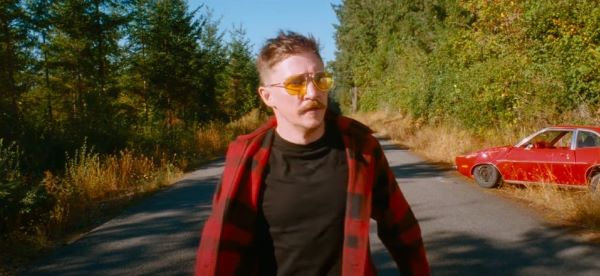2023 Film Festivals/2024 Theatrical Release/1h 37m
In a summer that’s short on must-see movies, “Strange Darling” ranks as essential viewing for fans of neo-noir thriller/horror flicks. A riveting story of a serial killer on the loose in rural Oregon, the film has much to recommend it: compelling creepy characters; superb acting; first-rate visuals; gritty intensity; and taut pacing, clocking in at 96 minutes. But most memorably, “Strange Darling” upends our expectations of the genre in a strikingly original way.
Bookended by stark black and white photography, the film opens with a moody shot, introducing us to the two leads: the red-headed, doe-eyed Lady (Willa Fitzgerald) and the clean-cut, rugged Demon (Kyle Gallner) – two easy-on-the-eyes, mutually attracted strangers who are sitting in the Demon’s truck swigging booze late one night, deciding whether they will take their party to a room at the nearby Blue Angel hotel. She comments that violence is always a risk for a woman in this situation and asks him if he’s a serial killer. He says no. From there, the story unfolds in six non-linear chapters.
Chapter 3 “Can you please help me?” comes first (and the phrase pops up several times throughout the movie). The next morning, the Lady, pale and frail but wiry, is now a blonde and has changed into hideous red scrubs. Driving a red Pinto, she floors it frantically down a quiet road. The gun-toting Demon is in determined, coke-fueled pursuit, but she escapes into dense, sun-dappled woods and eventually pounds on the door of a rustic cabin, occupied by hippie/doomsdayers (with a penchant for butter-laden breakfasts) Genevieve (Barbara Hershey) and Frederick (Ed Begley Jr.), and they let her in.
Terrified, wounded, hungry and hungover, she feasts, like a feral animal, on what’s left of their hearty morning meal. But when Frederick suggests they call the cops, the Lady vehemently disagrees. (Later, we do meet two officers, well played by Steven Michael Quezada and Madisen Beaty, who fall into a figurative snare that’s constructed from gender stereotypes.)
To reveal more of the plot would ruin the movie, so suffice to say as writer/director JT Mollner skillfully puts the puzzle pieces together, holes are tightened and questions are answered. That is, except for the most perplexing, probably unanswerable, question: how do people become crazy enough to go on a bloody killing binge with zero remorse?
Watching this masterful work, you feel the influence of Quentin Tarantino, the Coen brothers, Martin Scorsese, Michael Mann, David Lynch and Alfred Hitchcock. Mollner delivers a picture (his second) that’s bold, clever, sordid and sometimes darkly comic. Shot in 35 mm by cinematographer Giovanni Ribisi, “Strange Darling” is great-looking throughout – boasting rich color and arresting compositions. Composer Craig DeLeon’s score and original songs written and performed by Z Berg help to sustain the suspenseful mood.
Additionally, Mollner elicits terrific performances from the entire cast and especially from the captivating Fitzgerald as she pulls out all the stops playing a Lady you’ll never forget and Gallner, by turns sinister and phlegmatic; threatening and vulnerable.
Granted, “Strange Darling” won’t be everyone’s cup of blood. It’s a dark dive into the world of a serial killer, so if gore and graphic violence are a deal-breaker, you’ll want to give this a pass. (Also, if you’re looking for deep, thoughtful commentary on gender roles and sexual politics, look elsewhere.)
But for those who dig crime tales, sly, stylish “Strange Darling” takes us on a weird and wild ride.
“Strange Darling” opened Aug. 23 and is playing in theaters nationwide.












From FNB readers